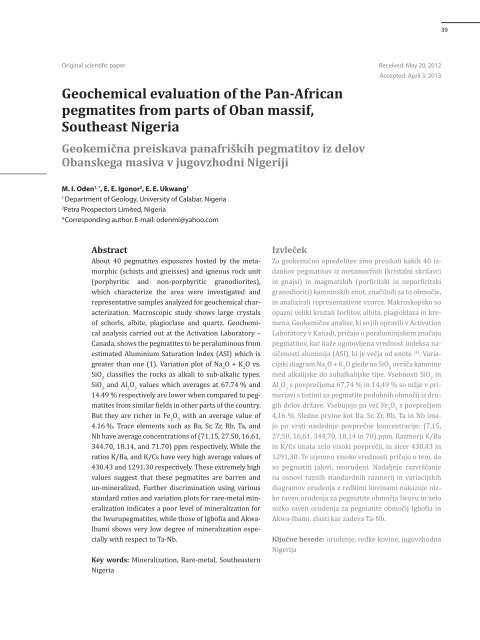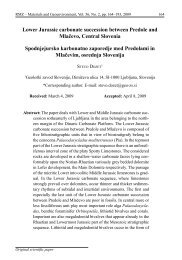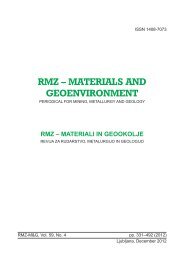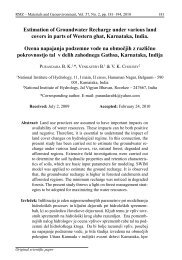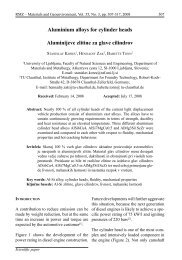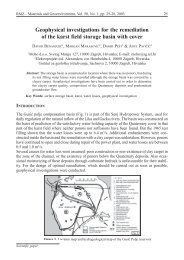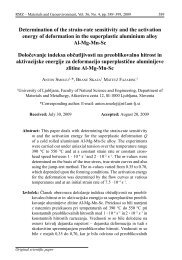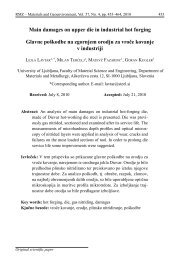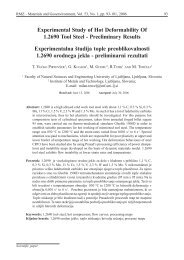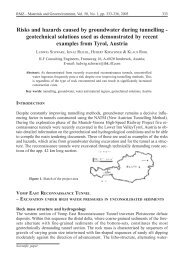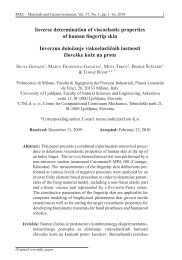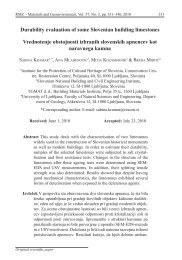Geochemical evaluation of the Pan-African pegmatites from ... - RMZ
Geochemical evaluation of the Pan-African pegmatites from ... - RMZ
Geochemical evaluation of the Pan-African pegmatites from ... - RMZ
You also want an ePaper? Increase the reach of your titles
YUMPU automatically turns print PDFs into web optimized ePapers that Google loves.
43Results <strong>of</strong> <strong>the</strong> major oxide geochemistry <strong>of</strong> <strong>the</strong><strong>pegmatites</strong> <strong>from</strong> study area are as shown in Table1. The results show that Igb<strong>of</strong>ia<strong>pegmatites</strong>are <strong>the</strong> most siliceous and aluminous, whileIwuru<strong>pegmatites</strong> are <strong>the</strong> poorest in SiO 2andCabut richer in Fe. Generally, <strong>the</strong> <strong>pegmatites</strong>are high in aluminous content and are seen tobe peraluminous (Figure 2). But Iwuru pegmatiteis relatively slightly depleted in aluminacontent. Based on <strong>the</strong> high silica and alkali pluslow CaO content, <strong>the</strong> <strong>pegmatites</strong> <strong>of</strong> AkwaIbamiand Iwuru area, are more granitic in composition,while <strong>the</strong> Igb<strong>of</strong>ia area tends towardsgranodioritic composition because <strong>of</strong> <strong>the</strong>ir highsilica, CaO, MgO, and low alkali content. The areashave a reasonably high Fe-number rangingbetween 0.66 and 0.77. The calculated Modified-Alkali-Lime-Index(MALI) shows positivevalues for both AkwaIbami and Iwuru areas,while it is negative for <strong>the</strong> Igb<strong>of</strong>ia group with anarrow range.Figure 4: Plot <strong>of</strong> Rb vs Sr showing <strong>the</strong> likely depth <strong>of</strong> origin for<strong>the</strong> <strong>pegmatites</strong> <strong>of</strong> study area (after Brown et. al., 1979).Figure 5: Plots <strong>of</strong> Ta vs K/Cs <strong>of</strong> <strong>pegmatites</strong> <strong>from</strong> study area(after Beus, 1966 and Gordiyenko, 1971).Table 2 shows values <strong>of</strong> trace elements and elementalratios for <strong>the</strong> <strong>pegmatites</strong> <strong>from</strong> studyarea. This shows selected trace elements suchas Ba, Sr, Zr, Rb, Ta, Nb and Cs having averageconcentrations <strong>of</strong> 71.15 ppm, 27.5 ppm,16.61 ppm, 344.7 ppm, 18.14 ppm, 71.7 ppmand 24.5 ppm respectively. Trace element ratios<strong>of</strong> K/Ba and K/Cs have very high averagevalues <strong>of</strong> 430.43 and 1291.30 while Ta:Cs ratiois far below 10 for all samples.According to Frost et al., (2001), a reason <strong>the</strong>serocks are peraluminous could be as a result<strong>of</strong> <strong>the</strong> parent melt having ano<strong>the</strong>r aluminousphase present, which could be aluminous biotiteor muscovite, garnet or an Al 2O 5polymorph.Also Miller, (1985) believes that such rockscould have formed <strong>from</strong> strongly peraluminousmelt which was derived <strong>from</strong> <strong>the</strong> melting <strong>of</strong> biotitebearing metaluminous felsic rocks.According to Ekwueme and Ma<strong>the</strong>is, (1995)it is inferred that <strong>the</strong> magma which produced<strong>the</strong>se <strong>pegmatites</strong> must have been alkaline innature hence <strong>the</strong> high alkali content <strong>of</strong> <strong>the</strong>se<strong>pegmatites</strong>.The high Fe-number <strong>of</strong> <strong>the</strong> <strong>pegmatites</strong> probablyreflects a high modal proportion <strong>of</strong> a ferromagnesianmineral e.gbiotite (Frost et at.,2001). And <strong>the</strong> narrow range in <strong>the</strong> Fe-numbervalues signifies similarity in source rock compositionand or nearness in degree <strong>of</strong> meltingundergone by rocks (Patino and Beard, 1996;Nabelek et al., 1991). Similarly, <strong>the</strong> narrowrange in MALI supports <strong>the</strong> <strong>the</strong>ory <strong>of</strong> similarparent source for <strong>the</strong> <strong>pegmatites</strong> <strong>of</strong> <strong>the</strong> studyarea (Frost et al., 2001).The moderately high values <strong>of</strong> Cs indicate moderatelyhigh alkali metal fractionation (Cerny,1982, 1989). Ta:Nb ratio ranges between 0.1to 0.41. This suggests a preference for possibleNb enrichment. But Ta and Nb values are obviouslytoo low for any pr<strong>of</strong>itable mineralizationin tantalum and or niobium. Also since residualfluids, which form Ta rich <strong>pegmatites</strong>, are enrichedin Ga (Cerny, 1982), <strong>the</strong> low level <strong>of</strong> Gain <strong>the</strong> <strong>pegmatites</strong> <strong>of</strong> study area indicates a nearimpossibility <strong>of</strong> Ta mineralization. The higherthan normal content <strong>of</strong> Rb (150 ppm – Taylor,1965) is indicative that <strong>the</strong> melts which formed<strong>the</strong>se rocks, have undergone high degree <strong>of</strong>partial melting <strong>of</strong> source material. It can besaid that <strong>the</strong> <strong>pegmatites</strong> <strong>of</strong> study area, originate<strong>from</strong> average depth intrusions (20-30 km) since<strong>pegmatites</strong> originating <strong>from</strong> deeper intrusionshave been shown to have similar low values <strong>of</strong><strong>Geochemical</strong> <strong>evaluation</strong> <strong>of</strong> <strong>the</strong> <strong>Pan</strong>-<strong>African</strong> <strong>pegmatites</strong> <strong>from</strong> parts <strong>of</strong> Oban massif, Sou<strong>the</strong>ast Nigeria
44Table 2: Trace element and elemental ratio composition <strong>of</strong> <strong>pegmatites</strong> <strong>of</strong> parts <strong>of</strong> Oban massif, SE NigeriaElements (ppm) T1 T2 T3 T4 T5 T6 T7 T8Ba 84 23 54 51 168 84 51 118Rb 212 23 563 914 288 265 337 156Sr 11 38 13 17 61 18 18 44Y 1 1 1 4 3 1 1 5Zr 26 39 3 18 21 8 9 9Nb 131 259 33 53 38 14 13 32Th 6 1 1 2 2 5 2 2Pb 5 12 18 29 14 13 18 16Ga 37 34 27 42 23 19 23 16Zn 533 2133 2236 1246 5247 2851 3385 3280Cu 11 14 18 20 25 20 15 47Ni 1 5 6 4 8 7 14 15V 2 4 3 3 17 7 6 18Cr 7 28 36 20 44 39 36 104Hf 3 4 0.3 2 2 1 1 0.4Cs 15 27 13 62 22 9 29 18Sc 0.3 2 0.4 1 2 0.3 1 2Ta 53 429 14 15 1 4 7Co 1 1 1 1 2 1 3 4Li 11 56 5 7 73 43 15 118Be 124 580 5 49 59 11 6 331K/Ba 500 104 856 847 174 289 575 98Na/K 7 22 0.8 1 0.27 0.1 1 0.4Rb/Sr 19 0.6 43 54 5 15 19 4K/Rb 47 105 82 47 83 92 90 74K/Cs 667 89 3527 700 1077 2641 997 634Th/U 2 0.4 0.4 0.3 0.1 1 0.3 1N.B: T1, T2 – average <strong>of</strong> samples <strong>from</strong> Igb<strong>of</strong>ia area; T3, T4, T5 – average <strong>of</strong> samples <strong>from</strong> Akwa Ibami area; T6, T7, T8 – average <strong>of</strong>samples <strong>from</strong> Iwuru area. T5 and T8 are muscovite extracts. Average values are <strong>of</strong> five samples in each case.Zr and aplite area less commonly found in associationwith <strong>the</strong>m (Cerny, 1992). This factis fur<strong>the</strong>r buttressed by <strong>the</strong> graph <strong>of</strong> Rb vs Sr(Figure 4). Also <strong>the</strong> low Zr content is indicative<strong>of</strong> an almost no crustal derivation. Since <strong>the</strong>se<strong>pegmatites</strong> have, Ta:Cs ratio far below 10, <strong>the</strong>yconveniently group in <strong>the</strong> lack to low mineralized<strong>pegmatites</strong> <strong>of</strong> <strong>the</strong> world. (Moller and Mortteani,1989; Cerny, 1992.)Low values <strong>of</strong> K/Ba and K/Cs are believed tobe indicative <strong>of</strong> mineralized <strong>pegmatites</strong> (Garba,2001). Thus <strong>the</strong> extremely high values in <strong>pegmatites</strong><strong>of</strong> study area suggest that <strong>the</strong>se <strong>pegmatites</strong>are barren and unmineralised. Fur<strong>the</strong>reconomic mineralization <strong>of</strong> <strong>the</strong>se <strong>pegmatites</strong><strong>from</strong> Oban massif was evaluated using variationplots <strong>of</strong> Ta vs K/Cs (Figure 5), Ta vs Ga(Figure 6), K/Rb vs Rb (Figure 7), and K/Rbvs Cs (Figure 8). As any rock falling below <strong>the</strong>defining line <strong>of</strong> mineralization <strong>of</strong> Beus, (1966)and Gordiyenko, (1971) is considered barren,while those plotting above <strong>the</strong> lines are consideredmineralized, <strong>the</strong> pegmatrites <strong>from</strong> Iwuruare barren as <strong>the</strong>y plot far below both mineralizationboundaries. But <strong>the</strong> <strong>pegmatites</strong> <strong>of</strong> Igb<strong>of</strong>iaand Akwa-Ibami have a very low mineralizationpotential as <strong>the</strong>y are seen to plot above<strong>the</strong> defining line <strong>of</strong> Beus, (1966), but below that<strong>RMZ</strong> – M&G | 2013 | Vol. 60 | pp. 39–46Oden, M. I., Igonor, E. E., Ukwang, E. E.
46Brown, E. H., Babcock, R. S., and Clark, M. D., (1979).Geology <strong>of</strong> Precambrian rocks <strong>of</strong> Grand Canyon: inPetrology and Structure <strong>of</strong> Vishu complex. Prec. Res.Vol. 8, pp. 219–241.Cerny, P., (1982). Anatomy and classification <strong>of</strong> granitic<strong>pegmatites</strong>: in CERNY PETR (ed.), short course ingranitic <strong>pegmatites</strong>. Mineralog. Assoc. Canada shortcourse handbook, Vol. 8, pp. 1–39.Cerny, P., Trueman, D.L., Ziehlke, D. V., Goad, B. E., andPaul, B. J. (1981). The Cat Lake-Winnipeg River andWekusko Lake pegmatite fields, Manitoba; ManitobaDept <strong>of</strong> Energy and Mines, economic geology ReportER 80–1, 216p.Ekwueme, B. N. and Ma<strong>the</strong>is, G. (1995). Geochemistry andeconomic value <strong>of</strong> <strong>pegmatites</strong> in <strong>the</strong> Precambrianbasement <strong>of</strong> sou<strong>the</strong>ast Nigeria in : R. K. Srivastavaand R. Chandra (Eds.), magmatism in relation todiverse tectonic settings. Oxford and IBH Publ. Co.PVT Ltd. New delhi, p. 375–392.Ekwueme, B. N. and Schlag, C. (1989). Compositions <strong>of</strong>monazites in <strong>pegmatites</strong> and related rocks <strong>of</strong> Obanmassif, sou<strong>the</strong>ast Nigeria: implications for economicmineral exploration. IGCP No. 255 Newsletter/bulletin,2, 15–20.Ekwueme, B. N., (1989). Tectono<strong>the</strong>rmal evolution <strong>of</strong> <strong>the</strong>Oban massif, Nigeria. 28th Intern. Geol. Congr. WashingtonD. C., Abstr. Vol. 4, pp. 439–440.Ekwueme, B.N., (1990d). On <strong>the</strong> occurrence <strong>of</strong> crystalline(basement complex) rocks in SW Ugep, Nigeria. Jour.Min. geol. Vol. 26(1), pp. 69–74.Frost, B. R., Barnes, C. G., Collins, W. J., Arculus, R. J., Ellis,D. J. and Frost, C. D. (2001). A geochemical classificationfor granitic rocks. Journ. Of petrology, Vol. 42, pp.2033 –2048.Frost, C. O. and Frost, B. R., (1997). High K, iron-enrichedRapakivi-type granites. The tholeiite connection.Geology, Vol. 25, pp. 647–650.Garba, I., (2001). Late <strong>Pan</strong>-<strong>African</strong> tectonic structures andorigin <strong>of</strong> gold and tin-tantalum mineralization inNigeria. 37th Ann. Intern.Conf. Nigerian Mining andGeosc. Soc. Jos, Nigeria, abstract. P9.Gordiyenko, V. V., (1971). Concentration <strong>of</strong> Li, Rb, and Csin <strong>the</strong> potash feldspar and muscovite as criteria forassessing <strong>the</strong> rare-metal mineralization in granitic<strong>pegmatites</strong>. Intern. Geology Rev. 13:131–142.Igonor, E. E., Oden, M. I., and Ukwang, E. E. (2010).<strong>Geochemical</strong> <strong>evaluation</strong> <strong>of</strong> basement rocks withinIgb<strong>of</strong>ia-uyanga-Iwuru area, SE Nigeria. 46th Annu.Conf. Nig. Min. Geosci. Soc., Calabar, Nigeria, abstract,pp. 9Jacobson, R. and Webb, J.S., (1946). The <strong>pegmatites</strong> <strong>of</strong>central Nigeria. Geol. Surv. Nig. Bull., 17Kingsley, A. E. and Ekwueme, B. N., (2009). Mineralization<strong>of</strong> <strong>pegmatites</strong> in parts <strong>of</strong> <strong>the</strong> Oban massif, sou<strong>the</strong>asternNigeria: a preliminary analysis. Chin. Jour.Geochem. Vol, 28, pp. 146–153.Maniar, P. D. and Piccoli, P. M., (1989). Tectonic discrimination<strong>of</strong> granitoids. Geol. Soc. Ame. Bull. Vol. 101,pp. 635–643.Ma<strong>the</strong>is, G and Caen-Vanchette, M. (1983). Rb-Sr isotopicstudy <strong>of</strong> rare-metal bearing and barren <strong>pegmatites</strong>in <strong>the</strong> <strong>Pan</strong>-<strong>African</strong> reactication zone <strong>of</strong> Nigeria. Journ.Of <strong>African</strong> Earth Science, Vol. 1, pp. 35–40.Miller, C. F. (1985). Are strongly peraluminous magmasderived <strong>from</strong> politic sedimentary sources? Journ.Geology, Vol. 93, pp. 673–689.Moller, P., and Morteani, G., (1987).<strong>Geochemical</strong> guide fortantalum <strong>pegmatites</strong>. Economic Geology, Vol. 12, pp.1885-1897.Oden, M. I. (2010). The pegmatite veins <strong>of</strong> western Obanmassif: tectonic and lithological controls on physicalproperties. 46thannu. Conf. Nig. Min. Geosci. Soc.,Calabar, Nigeria, Abstract, pp. 7Okunlola, O. A., (2004). Metallogeny <strong>of</strong> Tantalum-Niobiummineralization <strong>of</strong> Precambrian <strong>pegmatites</strong> <strong>of</strong> Nigeria.Book <strong>of</strong> abstract, Nigeria Mining and GeosciencesSoc.: Int. Conf. Maiduguri. pp. 24Patinodouce, A. E. and Beard, J. S. (1996). Effects <strong>of</strong> P, F(O2) and Mg/Fe ratio on dehydration melting <strong>of</strong>model metagreywackes.Journ. Of Petrology, Vol. 37,pp. 999 –1024.Raeburn, C., (1927). Tinstone in <strong>the</strong> Calabar District. Geol.Surv. Nigeria Bull. 11: 72–88.Straurov, O. O., Stolyarov, I. S. and Iocheva, E. I., (1966).Geochemistry and origin <strong>of</strong> Verkh – Isetgranitoidmassif in central Ural. Geochem.Intern. Vol. 6, pp.1138–1146.Taylor, R.S., (1965). The application <strong>of</strong> trace element datato problems <strong>of</strong> Petrology. In: L. Ahvens, F., Press, S.K. Runcorn and C. Urey(eds.), Physics and Chemistry<strong>of</strong> <strong>the</strong> Earth, Pergamon Press, Oxford, vol. 6, pp.133–214.Varlam<strong>of</strong>f, N., (1972). Central and West <strong>African</strong> rare-metalgranitic <strong>pegmatites</strong>, related aplites, quartz veinsand mineral deposits. Mineral Deposita (Berl.) 7:202–216.<strong>RMZ</strong> – M&G | 2013 | Vol. 60 | pp. 39–46Oden, M. I., Igonor, E. E., Ukwang, E. E.


